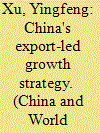| Srl | Item |
| 1 |
ID:
097824


|
|
|
|
|
| Publication |
2010.
|
| Summary/Abstract |
A pressing challenge for China is determining where to accommodate millions of migrant workers displaced by the closing of many export-oriented factories. The current global financial crisis has exposed the fragility of the export-led growth strategy China has adopted over the past 30 years. Is there a better alternative for providing non-agricultural jobs than the sweatshops of cheap export production? In the present paper, international experience is reviewed to shed light on China's situation. Using pooled regression models, we analyze data from the World Bank for 209 economies. We investigate the experience of other economies to answer the following questions: What is the common process of expanding the non-agricultural economy? How is that process affected by the level of the real exchange rate? Is export production a common way of absorbing surplus rural labor? Finally, what are the ways that domestic demand and service employment can be expanded?
|
|
|
|
|
|
|
|
|
|
|
|
|
|
|
|
| 2 |
ID:
090798


|
|
|
|
|
| Publication |
2009.
|
| Summary/Abstract |
Is the real appreciation of the Chinese yuan essential for correcting global imbalances? The present study offers a new perspective to the debate by drawing upon the rich international experience embodied in World Bank's World Development Indicators database. We find that the price levels of China and the United States are both low relative to the world's average. Therefore, the discrepancy between the price levels of China and the United States has been, in fact, close to zero since 2002. The difference in per capita income can fully account for the price difference between China and the United States. However, the Balassa-Samuelson effect is not a reliable guide for projecting the trend of real appreciation. According to the experience of those economies that have experienced real currency appreciation against the US dollar in 1985-2005, the mode of faster wage growth and inflation is as common as nominal appreciation, far more common for economies with a low initial price level. We do not find empirical evidence to substantiate the claim that low price levels tend to cause external surpluses. But real appreciation has a powerful effect in boosting job creation in the service sector. Therefore, the real appreciation of the Chinese yuan would contribute to restructuring the Chinese economy towards a domestic demand-based growth track.
|
|
|
|
|
|
|
|
|
|
|
|
|
|
|
|